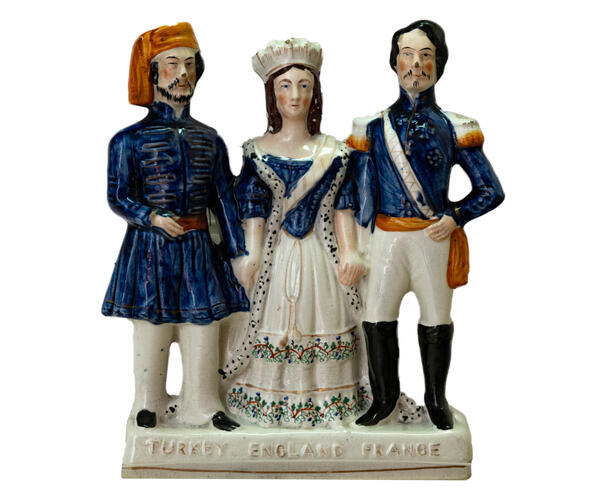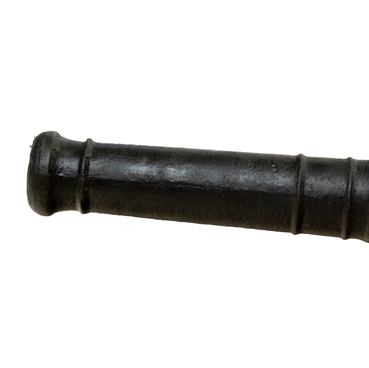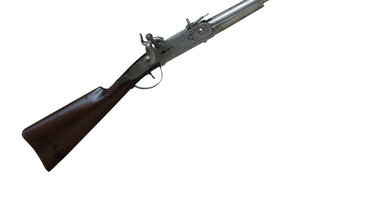The decorative figure group, presented in the exhibition, was made in the 50-60s of the 19th century at a factory in Great Britain.
The sculptural composition consists of three figures. The Queen Victoria of Great Britain is depicted in the center. To her left is the Turkish Sultan Abdul-Medjid I. He is wearing a knee-length blue camisole, white trousers and an orange fez — a cap with a tassel, a traditional headdress of the Middle Eastern countries. On the right side of the Queen there is the figure of Napoleon III, the Emperor of France. He is dressed in a military uniform: a blue uniform with white and orange epaulettes and awards on his chest.
All three figures stand on a pedestal on which “Turkey England France” is written in relief letters. The inscription indicates that in 1854 the countries concluded the Treaty of Constantinople.
On March 12, 1854, Queen Victoria, French Emperor Napoleon III and the 31st Sultan of the Ottoman Empire, Abdul Majid I, signed an agreement in Constantinople on the military alliance of Great Britain, France and Turkey against Russia. It signified the readiness of the Western powers to engage in the Crimean War.
The treaty consisted of a preamble summarizing the document itself and the list of parties involved, and five parts. The preamble stated that Great Britain and France “agree to provide the Turkish Sultan with the assistance he requested.” Also, the document read as follows: “The existence of the Ottoman Empire within its present borders is essential to maintain a balance of power between the states of Europe.”
The five articles of the treaty stated that Great Britain and France, at the request of the Sultan, sent their naval forces to Constantinople. The member-states also pledged to provide ground forces to protect Turkish possessions in Europe and Asia. The Sultan, in turn, confirmed that he would not conclude a separate peace agreement with Russia — a treaty signed in circumvention of the allies. In addition, the treaty regulated the stay of the Anglo-French troops in Turkey and the procedure for joint military operations. The validity period of the document was not indicated.
The Treaty of Constantinople became one of the most important diplomatic acts: it determined the balance of power in the Crimean War of 1853-1856. On March 16, 1854, immediately after it was signed, the parties officially declared war on Russia.
The sculptural composition consists of three figures. The Queen Victoria of Great Britain is depicted in the center. To her left is the Turkish Sultan Abdul-Medjid I. He is wearing a knee-length blue camisole, white trousers and an orange fez — a cap with a tassel, a traditional headdress of the Middle Eastern countries. On the right side of the Queen there is the figure of Napoleon III, the Emperor of France. He is dressed in a military uniform: a blue uniform with white and orange epaulettes and awards on his chest.
All three figures stand on a pedestal on which “Turkey England France” is written in relief letters. The inscription indicates that in 1854 the countries concluded the Treaty of Constantinople.
On March 12, 1854, Queen Victoria, French Emperor Napoleon III and the 31st Sultan of the Ottoman Empire, Abdul Majid I, signed an agreement in Constantinople on the military alliance of Great Britain, France and Turkey against Russia. It signified the readiness of the Western powers to engage in the Crimean War.
The treaty consisted of a preamble summarizing the document itself and the list of parties involved, and five parts. The preamble stated that Great Britain and France “agree to provide the Turkish Sultan with the assistance he requested.” Also, the document read as follows: “The existence of the Ottoman Empire within its present borders is essential to maintain a balance of power between the states of Europe.”
The five articles of the treaty stated that Great Britain and France, at the request of the Sultan, sent their naval forces to Constantinople. The member-states also pledged to provide ground forces to protect Turkish possessions in Europe and Asia. The Sultan, in turn, confirmed that he would not conclude a separate peace agreement with Russia — a treaty signed in circumvention of the allies. In addition, the treaty regulated the stay of the Anglo-French troops in Turkey and the procedure for joint military operations. The validity period of the document was not indicated.
The Treaty of Constantinople became one of the most important diplomatic acts: it determined the balance of power in the Crimean War of 1853-1856. On March 16, 1854, immediately after it was signed, the parties officially declared war on Russia.



